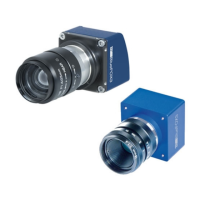7.4 Relationship between driver, firmware, FPGA file and
user settings
To operate a GenICam based device like mvBlueFOX3 apart from the physical hardware itself 2
pieces of software are needed:
A firmware running on the device. This firmware consists of
A GenICam compliant XML file exposing the features in a generic and standard
compliant way
♦
A FPGA file♦
The actual micro-code making the device operational♦
•
A device driver (this is the mvGenTLConsumer.dll and the mvGenTLProducer.cti on
Windows and the libmvGenTLConsumer.so and the libmvGenTLProducer.so on
Linux when using mvIMPACT Acquire, but can be any other USB3 Vision compliant driver
package from a third party vendor) running of the host system (provides control over the
device from an application running on the host system).
•
The physical GenICam compliant device has a firmware programmed into the device's non-volatile
memory, thus allowing the device to boot to a fully functional state without the need of any
additional software running on the host. The firmware version that will be used when operating the
device does NOT depend on the driver version that is used to communicate with the device. This
will allow any piece of compliant third party software to operate the device without the need to have
special knowledge about the firmware structure. This shall be illustrated by the following figure:
Figure 7: The firmware is not a part of the device driver
Note:
As it can be seen in the image the firmware file is NOT part of the device driver but comes
as a separate archive. It is important to notice that a firmware file that may be present on the
host system will *not* be used automatically but only when the user or an application
explicitly updates the firmware on the device and will only become active after power-cycling
the device.
The name of the firmware update archive (* in the figure above) is:
mvBlueFOX3_Update.mvu•
Only during a firmware update the firmware file that has been selected from the file system of the
host system will be downloaded permanently into the device's non-volatile memory.
Warning:
Each firmware archive might contain more than one specific firmware version per device
thus in order to select the one that is appropriate for the device appropriate tools such as
mvDeviceConfigure should be used.
7 Quickstart
45

